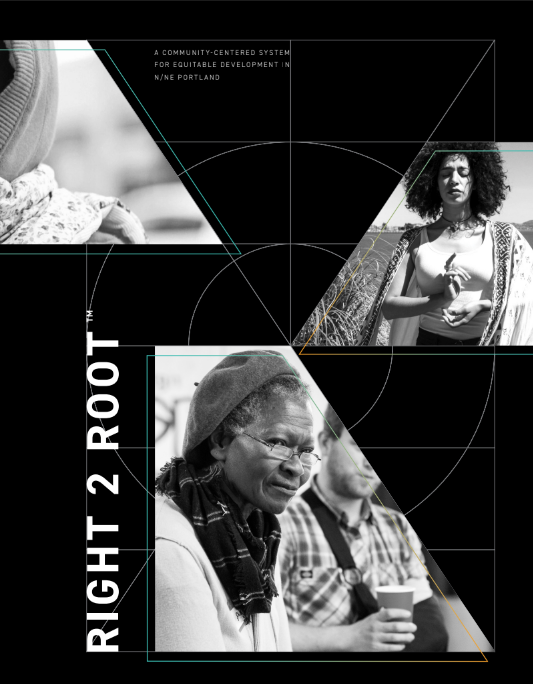Right to Root: A Community-Centered System for Equitable Development in N/NE Portland
Cat Goughnour
Introduction:
Radix Consulting Group’s Right 2 Root™ is a community-led, community-funded approach designed for community members affected by displacement and gentrification to work with planners, architects and other progressive firms to become architects of our own lives, communities, families, and futures. Understanding the impact of serial forced displacement on community cohesion, connectivity and wellbeing — known as root shock — our work makes safe spaces, while planning and making place. We make, replicate, and test the most innovative upstream solutions that have the biggest impact on our marginalized, socially vulnerable people. This community-led approach targets and uplifts women and children’s wellbeing to overcome trauma caused by gentrification and serial forced displacement.

Key Findings:
Poverty indicators presented in the report
This research examines racial inequities based on four poverty indicators: income, education, employment, and housing. Numbers for the most recent year of data show:
- 25% income gap: 40% of Black residents were below the poverty line, compared to about 15% of the White residents.
- 10% employment gap: 18% of Black residents were unemployed, compared to about 8% of White residents.
- 30% homeownership gap: 29% of Black households are owner-occupied, compared to 59% of White households.
- Additionally, three of the four indicators show racial disparities have been increasing over time.
New Poverty Reduction Lenses
The report uses three lenses to analyze root causes (indicators) of and solutions to poverty: health, maker, and innovation.
- The health lens addresses more than the absence of disease or infirmity. Healthy communities must also feature safety, comprehensive transportation networks, and connection to affordable, quality food, housing, education, employment, and services.
- The maker (assets and capital) lens focuses on entrepreneurship, jobs, and careers, using cultural and intellectual capital as the engine of a maker culture and supportive infrastructure.
- The innovation lens focuses on upstream interventions that foster collaborative ownership and leveraging human capital. It increases capacity, recovery resilience, and appreciates the value of cultural knowledge and traditions.
Land Use
- Create mixed-use, culturally specific institutions, facilities, businesses, services employment, and education in transit-served space, and underutilized land
Transportation
- Increase access and reduce inefficiencies between areas of opportunity and disinvestment, and optimize connections between facilities, employment and education
Environment
- Cultivate a new open-space system to connect cultural and natural areas that promote and support community activities with community-controlled ecological processes

Land Use
- Prioritize collaborative ownership for adaptive and interim use of underutilized public and private lands to underserved communities
Transportation
- Create connective networks between nodes in Root (historic, stable) and Anchor (disinvested) areas, using express services to facilitate economic opportunity
Environment
- Expand green systems and make multi-modal paths and streets to green space and high-speed transportation systems supporting maker corridors

Land Use
- Incubate community and business programs in mixed-use, interim facilities that can be adapted for education and cultural events
Transportation
- Design purposeful connections between facilities, intended for community and business programs, that have a continuity of settings and experience and last-mile circulation.
Environment
- Transform built and natural spaces into connected, culturally supportive ecosystems that support multigenerational health, maker and innovative laboratories
A community resilience plan is refined by targeting the implementation scale (macro, mezzo, and micro) and by creating entities to articulate, steward, and advocate for beneficial regional land use, transportation, environmental policies and cooperative ownership.
- At the macro scale, policy directs system change, affecting entire communities. Resilient Dallas, part of the 100 Resilient Cities program, illustrates macro scale implementation.
- At the mezzo scale, policy and interventions incubate system change within neighborhoods, institutions, or other smaller groups. Restore Oakland is a precedent that illustrates how interventions foster capacity and align resources to achieve system change.
- At the micro scale, individuals and smaller community entities support and sustain system change. Seattle’s Africatown is a precedent that illustrates micro-scale implementation and the importance of community collaboration and stewardship.

Download our Press Brief [PDF]
For more info: info@right2root.com
Media Contacts:
Domenica Ghanem
domenica@ips-dc.org
202-787-5205
Robert Alvarez
robert@ips-dc.org
916-690-9896
